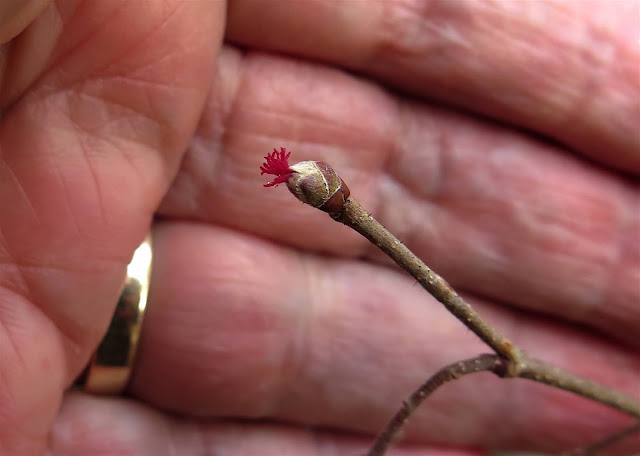What a great day it was for "firsts," this past Thursday! The first day this year the temperature reached past 70 degrees. The first day this year to hear Wood Frogs croaking in a woodland pool along the Spring Run Trail in Saratoga. The first time this year to find American Hazelnut shrubs in bloom, with both male and female flowers. The first day to find Speckled Alder's golden catkins swaying in the breeze. And best of all, the first time in months since my friend Sue Pierce and I, now both of us fully vaccinated against Covid, could hug each other, ride in the same car together, enjoy a nature walk together, and have lunch together inside a restaurant. A day to celebrate! Let our post-pandemic life begin!
Here's Sue trying to capture on video the distinctive duck-like "quacks" of some amorous, only recently thawed Wood Frogs in that Spring Run pool. We could hear them as soon as we neared this site, but of course they fell silent as soon as we approached their pool. But just wait! If we stand here silent enough and long enough, they will start their spring chorus once more. And so they did! A sound of spring like no other! We did hear other spring songs this day as well, all from the birds that happily inhabit this woodsy and watery spot: Red-winged Blackbirds, Goldfinches, Chickadees, Red-bellied and Pileated Woodpeckers, Winter and Carolina Wrens, and one full-throated Song Sparrow -- all announcing that spring is here at last!
Numerous alders -- both our native Speckled Alder (Alnus incana) and an introduced European Black Alder (Alnus glutinosa) -- thrive in the wetlands along the Spring Run Trail. I am not sure how to tell them apart, since their flowers look very similar. Both alder species produce dangling male catkins that lengthen and turn golden with pollen in spring, the catkin clusters surmounted by the reddish-scaled female flower buds, which are held higher on the twigs to lessen the chance of their own shrub's pollen dropping down on them.






Thank you so much! I was walking on Spring Run today and wondered what the heck - so many ducks in that pond behind the bushes :). So it’s frogs! I always enjoy your postings.
ReplyDeleteThank you, Jackie, for your photos and detailed description of the Alder's reproductive strategies. I was trying to make sense of an alder I saw today (up the road a piece from you) and this helped tremendously!
ReplyDelete